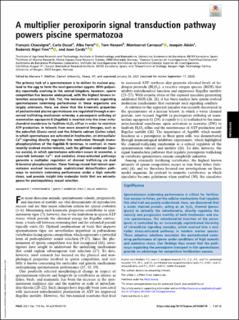| dc.description.abstract | The primary task of a spermatozoon is to deliver its nuclear payload to the egg to form the next-generation zygote. With polyandry repeatedly evolving in the animal kingdom, however, sperm competition has become widespread, with the highest known intensities occurring in fish. Yet, the molecular controls regulating spermatozoon swimming performance in these organisms are largely unknown. Here, we show that the kinematic properties of postactivated piscine spermatozoa are regulated through a conserved trafficking mechanism whereby a peroxiporin ortholog of mammalian aquaporin-8 (Aqp8bb) is inserted into the inner mitochondrial membrane to facilitate H2O2 efflux in order to maintain ATP production. In teleosts from more ancestral lineages, such as the zebrafish (Danio rerio) and the Atlantic salmon (Salmo salar), in which spermatozoa are activated in freshwater, an intracellular Ca2+-signaling directly regulates this mechanism through monophosphorylation of the Aqp8bb N terminus. In contrast, in more recently evolved marine teleosts, such the gilthead seabream (Sparus aurata), in which spermatozoa activation occurs in seawater, a cross-talk between Ca2+- and oxidative stress-activated pathways generate a multiplier regulation of channel trafficking via dual N-terminal phosphorylation. These findings reveal that teleost spermatozoa evolved increasingly sophisticated detoxification pathways to maintain swimming performance under a high osmotic stress, and provide insight into molecular traits that are advantageous for postcopulatory sexual selection. | en_US |
